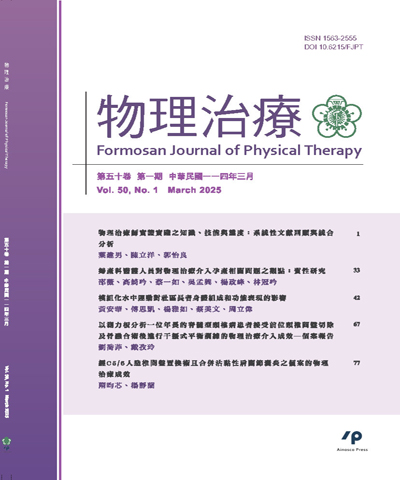
物理治療/Formosan Journal of Physical Therapy
社團法人臺灣物理治療學會 & Ainosco Press,正常發行
選擇卷期
- 期刊
背景與目的:根據國民健康局「臺灣中老年身心社會生活狀況長期追蹤調查」的資料顯示,關節炎名列常見慢性病的前五名,而退化性膝關節炎為其中之一。骨化性膝關節炎最常影響脛股關節的內側結構,原因可能是行走過程中此關節的內側承受較多的壓力所致,長期過多的負荷下,便會造成膝關節內翻變形(genu varum),如此一來,骨化性膝關節炎就更加嚴重。因此,本研究想要探討運用「功能導向」的運動訓練計畫強化下肢外側肌群之肌力,是否可以改善膝關節內翻現象,進而減輕膝關節炎的症狀及減緩膝關節退化的速度。方法:本次研究採隨機控制試驗(randomized controlled trial),分成二組,參與為期12週,每週3次的儀器治療(短波及干擾波)及運動訓練。實驗組(神經肌肉運動訓練)以一連串特定的運動計畫組合為主,調整訓練運動的困難度方法包括動作重複次數、方向及速度,增加阻力或改變支撐表面;控制組(傳統運動訓練)則為漸進式阻力關節運動。以疼痛指數、Western Ontario and McMaster Universities Osteoarthritis Index (WOMAC)、下肢肌肉力量、3項功能性活動測試(坐到站、上下樓梯、平衡測試)及Kellgren-Lawrence grading system來評估訓練成效。結果:本研究共選取16位退化性膝關節受試者,4位男性,12位女性,平均年齡59.6歲,11位完成資料收集並分析結果。結果顯示訓練後下肢之肌肉力量兩組皆有進步,實驗組訓練6週後膝關節伸直肌、屈曲肌群及髖關節外展肌群肌力有顯著進步(全部p = 0.043),控制組訓練後肌力雖有改善但無明顯差異(全部p > 0.05);控制組30秒坐到站的次數有顯著進步(p = 0.042);X光檢查顯示兩組皆無明顯改變;功能性活動及WOMAC失能問卷結果亦有改善現象,但沒有顯著差異(p = 0.686)。結論:本研究結果顯示,透過早期介入的神經肌肉運動訓練方式除了增強輕度膝關節炎患者膝伸直肌及屈曲肌群外,也強化了髖關節外展肌群力量,可減輕膝關節內側負荷,提升下肢功能性活動的能力。臨床意義:功能性導向的神經肌肉訓練模式,能改善輕度退化性膝關節的症狀,尤其是強化膝關節肌群及髖關節外展肌群之肌力,減少下肢失能程度。
- 期刊
背景與目的:兒童實習物理治療中的溝通能力是很重要的一環,特別如何與家長和個案溝通及衛教說明,並且將活動放入日常生活活動中是目前的趨勢,但是如何能夠作有效的溝通一直是教學中很缺乏的,特別是目前也很少的時間專門對溝通能力作訓練。作者參考Fannie和George Shaftels於1967年所建立的角色扮演教學模式,角色扮演強調以行動來處理問題,必須有些學生扮演角色,有些學生觀察。在扮演中個人要設身處地與他人互動,從中激發種種感受,以作為之後的分析基礎。在醫病溝通的教學中,老師可以在扮演的歷程中提供現實生活中的實例,以幫助學生洞察醫病關係的態度、價值、知覺,探討發生的情感,甚至於發展解決醫病溝通困境及問題的技巧與態度。本篇目的為評估學生在接受此方式的教學方法後的溝通技巧是否進步及對此教學方法的滿意度。方法:參考Joyner和Young於2006年的實際將角色扮演模式運用於醫學生的教學活動之中,並提出12個實施要點,包含:事前準備、釐清學習目標、建立醫療案例、整合角色扮演的場景劇本、足夠的時間、全部參與、定義基本規則、讓觀察者有事做、結構化的評量量表、確認參與者都得到報告及回饋、鼓勵反思、保持幽默感。在總共15位物理治療實習生臨床學習中利用常見的個案狀況錄影,學生看完影片學生自己先互相練習並且加入溝通的部分-包括如何跟家屬溝通,了解家屬的問題和目標,再跟老師練習,和老師互相討論,再進行回饋評鑑與省思。老師覺得學生通過後再實際跟個案及家屬實作。第一週和第六週用:(1)Mini-clinical evaluation exercise (CEX)(每1項為1~6分),其中包含溝通技巧、治療後衛教;(2)教師和學生滿意度(1~10分)並使用配對t檢定比較教學前後是否有差異。結果:溝通能力前測平均為3.8 ± 0.56,溝通能力後測平均為4.4± 0.73,學生滿意度前測平均為6.66 ± 0.97,學生滿意度後測平均為7.73 ± 0.88。統計結果溝通能力後測分數與後測總分呈現高度正相關(r =0.844, p < 0.05)溝通分數差異與總分差異成高度正相關(r = 0.713, p = 0.003)。溝通能力後測成績與學習滿意度呈現中度正相關(r = 0.614, p= 0.015)、與兒童Mini-CEX總分呈現高度正相關(r = 0.844, p < 0.005)。結論:學生的溝通能力和整體表現有高度相關性,溝通能力也與學習的滿意度有相關。表示溝通能力影響整體的學習表現。透過影片教學、角色扮演可以提升溝通能力、學習整體效果及學習滿意度。臨床意義:臨床上對於溝通能力的訓練可以使用影片及角色扮演,藉由教導、示範、練習並雙向回饋和反思來提升實習生的溝通能力及技巧,期待藉由更實證及更有效的方式來提升溝通能力並且提升整體的學習成效。
- 期刊
Background and Purpose: Infants with prematurity, low birth weight or hypoxic encephalopathy are at higher risks for developmental delay. The qualitative assessment of general movements (GMsA) based on observation of infant’s spontaneous movements is a method with minimal handling to detect the integrity of the central nerve system The purposes of this study are to examine the predictive validity of GMsA trajectory on motor development outcome at 1 year of age. Methods: Sixty nine infants who met the inclusion criteria of high risk in developmental delay were recruited from Neonatal Intensive Care Unit (NICU) of National Cheng Kung University Hospital. Spontaneous movements were recorded by at least two digital camcorders from preterm, writhing fidgety periods. Motor development outcome was measured by Peabody developmental motor scale second edition (PDMS-2) and Alberta infant motor scale (AIMS) at 1 year of age. The GMsA were dichotomized to normal and abnormal for the purpose of analysis. The sensitivity, specificity, positive predictive value (PPV), negative predictive value (NPV) and accuracy were calculated. Trajectory was considered abnormal end or consistent abnormal as abnormal. Motor development outcome was determined by AIMS at 1 years of age with cutoff point of 10%. The cutoff point of PDMS- 2 was total motor quotient score of 85. Results: Fifty five and 14 of participants were classified as normal and abnormal based on GMsA trajectory, respectively. GMsA had a specificity of 91%, sensitivity of 75%, NPV 94%, PPV of 64% and accuracy of 88% in predicting motor delay at 1 year of age. The GMs trajectory had an accuracy of 79-85% for predicting motor outcome at 2 years which was better than that of in preterm and writhing period. The predictive validity found in this study was similar to the previous findings on infants with more severe health conditions. Conclusion: This study indicated that the predictive validity of GMsA using trajectory data on motor development at 1 year of age was good and better than the prediction validity of each single period. Clinical Relevance: GMsA has the advantage of being noninvasive and minimal handling which is suitable for fragile high risk infants. This study helps to establish the evidence base for GMsA, and suggests the use of GMsA trajectory instead of a single period.

